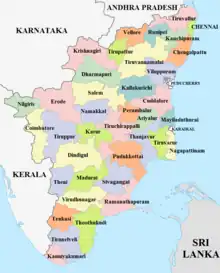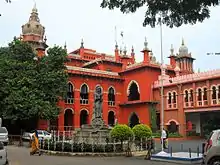 | |
| State | Tamil Nadu |
|---|---|
| Website | www |
| Legislative branch | |
| Assembly | |
| Speaker | M. Appavu, DMK |
| Deputy Speaker | K. Pitchandi, DMK |
| Members in Assembly | 234 |
| Meeting place | Fort St. George |
| Executive branch | |
| Governor | R. N. Ravi |
| Chief Minister | M. K. Stalin, DMK |
| Chief Secretary | Shiv Das Meena, I.A.S. |
| Headquarters | Chennai |
| Departments | 43 |
| Judiciary branch | |
| High Court | Madras High Court |
| Chief Justice | Sanjay V. Gangapurwala |
The Government of Tamil Nadu is the administrative body responsible for the governance of the Indian state of Tamil Nadu. Chennai is the capital of the state and houses the state executive, legislature and head of judiciary.
Under the Constitution of India, de jure executive authority lies with the governor, although this authority is exercised only by, or on the advice of, the chief minister, the de facto authority and the cabinet. Following elections to the Tamil Nadu Legislative Assembly, the state's governor usually invites the party (or coalition) with a majority of seats to form the government. The governor appoints the chief minister, whose council of ministers are collectively responsible to the assembly.
Legislative assembly elections are held every five years to elect a new assembly, unless there is a successful vote of no confidence in the government or a two-thirds vote for a snap election in the assembly, in which case an election may be held sooner. The legislature of Tamil Nadu was bicameral until 1986, when it was replaced by a unicameral legislature. The judiciary branch is led by a High Court (Madras High Court) led by a Chief Justice.
Executive
| Title | Name |
|---|---|
| Governor | R. N. Ravi[1] |
| Chief minister | M. K. Stalin[2] |
| Chief Justice | S. V. Gangapurwala[3] |
The Governor is the de jure constitutional head of state while the Chief Minister is the de facto chief executive. The governor is appointed by the President of India. Following elections to the Tamil Nadu Legislative Assembly, the state's governor usually invites the party (or coalition) with a majority of seats to form the government. The governor appoints the chief minister, whose council of ministers are collectively responsible to the assembly. Given that he has the confidence of the assembly, the chief minister's term is for five years and is subject to no term limits.[4] Chennai is the capital of the state and houses the state executive, legislative and head of judiciary.[5]
Council of Ministers
Legislature
The Tamil Nadu Legislative Assembly consists of 234 members elected through democratic elections. The current seat of the assembly is at Fort St. George in Chennai. The first election to the assembly on the basis of universal adult suffrage was held in January 1952.[6] The legislature of Tamil Nadu was bicameral until 1986, when it was replaced by a unicameral legislature after the abolishment of Tamil Nadu Legislative Council.[7] Any bill passed by the legislature needs the assent of the governor before becoming an act.
Judiciary
The Madras High Court was established on 26 June 1862 and is the highest judicial authority of the state with control over all the civil and criminal courts in the state.[8] It is headed by a Chief Justice and Justice Sanjay V. Gangapurwala is the Chief Justice of the Madras High Court.[9] The court is based out of Chennai and has a bench at Madurai since 2004.[10]
Administrative divisions

As per the 2011 census, Tamil Nadu had a population of 7.21 crores and is the seventh most populous state in India.[11] It covers an area of 130,058 km2 (50,216 sq mi) and is the tenth largest Indian state by area. Tamil Nadu is divided into 38 districts, each of which is administered by a District Collector, who is an officer of the Indian Administrative Service (IAS) appointed to the district by the Government of Tamil Nadu. For revenue administration, the districts are further subdivided into 87 revenue divisions administered by Revenue Divisional Officers (RDO) which comprise 310 taluks administered by Tahsildars.[12] The taluks are divided into 1349 revenue blocks called Firkas which consist of 17,680 revenue villages.[12] The local administration consists of 15 municipal corporations, 121 municipalities and 528 town panchayats in the urban and 385 panchayat unions and 12,618 village panchayats, administered by Village Administrative Officers (VAO).[13][12][14] Greater Chennai Corporation, established in 1688, is the second oldest in the world and Tamil Nadu was the first state to establish town panchayats as a new administrative unit.[15][13]
Departments
The administration of the state government functions through various secretariat departments. Each department consists of secretary to the government, who is the official head of the department with the Chief secretary superintending control over the secretariat and staff. The departments have further sub-divisions which may govern various undertakings and boards. There are 43 departments of the state.[16]
Insignia
The state emblem was designed in 1949 and consists of the Lion Capital of Ashoka without the bell lotus foundation and flanked on either side by an Indian flag with an image of a Gopuram or Hindu temple tower on the background. Around the rim of the seal runs an inscription in Tamil script, one at the top தமிழ் நாடு அரசு ("Tamil Nadu Arasu" which translates to "Government of Tamil Nadu") and the other at the bottom வாய்மையே வெல்லும் ("Vaymaiye Vellum" which translates to "Truth Alone Triumphs" also commonly known as "Satyameva Jayate" in Sanskrit).[17]
| Animal | Bird | Butterfly | Tree | Fruit | Flower |
|---|---|---|---|---|---|
| Nilgiri tahr (Nilgiritragus hylocrius) | Emerald dove (Chalcophaps indica) | Tamil Yeoman (Cirrochroa thais) | Palmyra palm (Borassus flabellifer) | Jackfruit (Artocarpus heterophyllus) | Glory lily (Gloriosa superba) |
See also
References
- ↑ "R. N. Ravi is new Governor of Tamil Nadu". The Times of India. 11 September 2021. Retrieved 13 September 2021.
- ↑ "MK Stalin sworn in as Chief Minister of Tamil Nadu". The Hindu. 7 May 2021. Retrieved 23 June 2021.
- ↑ "Justice SV Gangapurwala sworn in as Chief Justice of Madras HC". The News Minute. 28 May 2023. Archived from the original on 28 May 2023. Retrieved 28 May 2023.
- ↑ Durga Das Basu (1960). Introduction to the Constitution of India. LexisNexis Butterworths Wadhwa. p. 241-245. ISBN 978-81-8038-559-9.
- ↑ "Tamil Nadu". Britannica. Retrieved 1 December 2023.
- ↑ "1952 Election" (PDF). Retrieved 12 February 2013.
- ↑ "The State Legislature–Origin and Evolution". Government of Tamil Nadu. Retrieved 1 February 2023.
- ↑ "History of Madras High Court". Madras High Court. Retrieved 1 January 2023.
- ↑ "Madras High Court - Profile of Chief Justice". Madras High Court. Retrieved 26 November 2021.
- ↑ "History of Madras High Court, Madurai bench". Madras High Court. Retrieved 1 January 2023.
- ↑ Population and decadal change by residence (PDF) (Report). Government of India. p. 2. Retrieved 1 December 2023.
- 1 2 3 "Government units, Tamil Nadu". Government of Tamil Nadu. Retrieved 1 January 2023.
- 1 2 "Local Government". Government of India. p. 1. Retrieved 1 January 2023.
- ↑ Statistical year book of India (PDF) (Report). Government of India. p. 1. Retrieved 1 January 2023.
- ↑ "Town panchayats". Government of Tamil Nadu. Retrieved 1 January 2023.
- ↑ "List of Departments". Government of Tamil Nadu. Retrieved 1 December 2023.
- ↑ "Which Tamil Nadu temple is the state emblem?". Times of India. 7 November 2016. Retrieved 20 January 2018.
- ↑ "State Symbols of India". Ministry of Environment, Forests & Climate Change, Government of India. Retrieved 30 August 2023.
- ↑ "Symbols of Tamil Nadu". Government of Tamil Nadu. Retrieved 12 August 2023.

